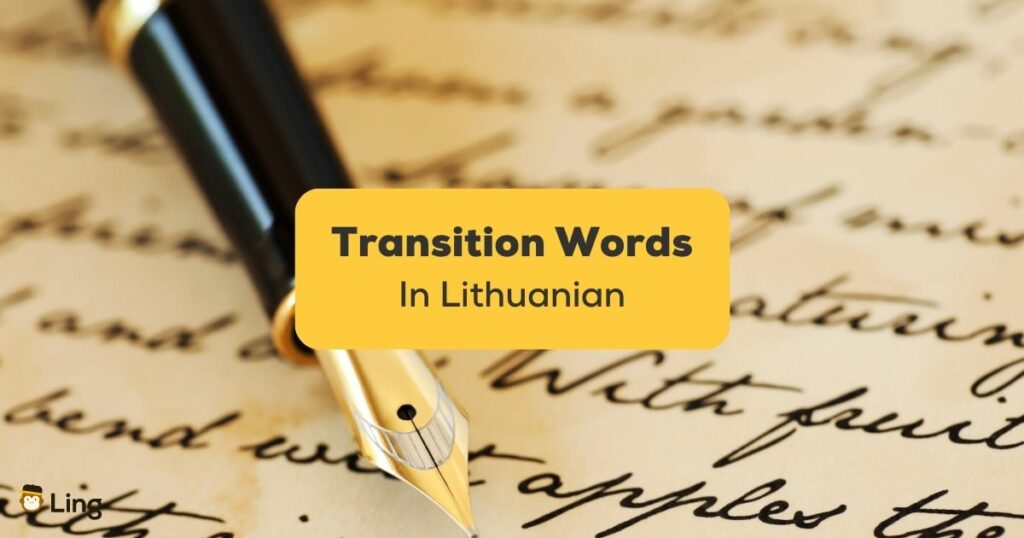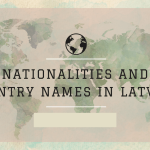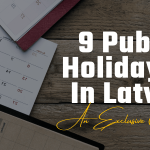Learning a new language is like embarking on a captivating journey through the niches of communication and writing. Every language has its unique features, and mastering these intricacies can make a significant difference in your ability to express yourself effectively.
One such feature in the official language of Lithuania is the use of transition words, which play a crucial role in guiding the flow of your speech and writing. In this guide, we will explore the world of Lithuanian transition words, their meanings, usage, and how they fit into the broader landscape as you learn the Lithuanian language.
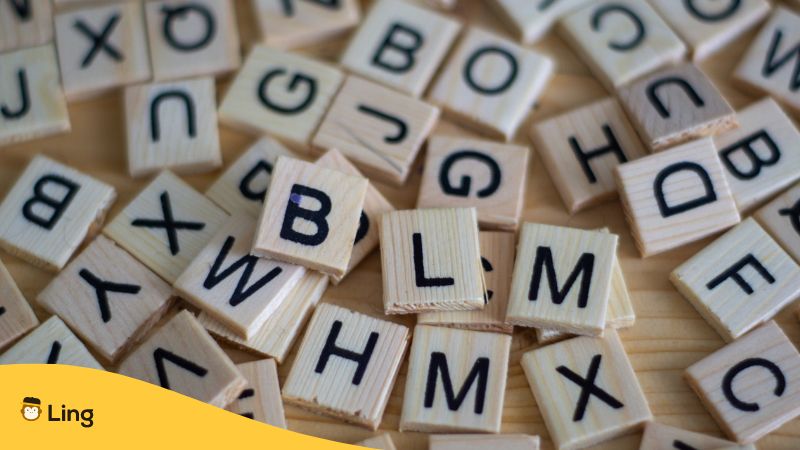
15 Common Lithuanian Transition Words
Transition words are essential tools that help you smoothly connect ideas, show relationships between sentences, and ensure the coherence of another language in your discourse. They help in speaking but especially writing in a new language as well. They give you ideas on how to start, finish, and connect sentences.
Here’s a table of 15 commonly used Lithuanian transition words along with their English counterparts.
| English | Lithuanian |
|---|---|
| Firstly | Pirma |
| Moreover | Be to |
| However | Tačiau |
| On the other hand | Kita vertus |
| In addition | Be to |
| Therefore | Todėl |
| For example | Pavyzdžiui |
| Nevertheless | Nepaisant to |
| Furthermore | Be to |
| Meanwhile | Tuo tarpu |
| In conclusion | Baigiant |
| In fact | Iš tikrųjų |
| Finally | Galiausiai |
| Otherwise | Kitu atveju |
| In summary | Apibendrinant |
Want more resources to help you learn and speak Lithuanian? Download the language-learning Ling app today from the App Store and Play Store.
Using Lithuanian Transition Words: Explanation & Examples
Let’s take a look at how and when to use these transition words in our writing and in our speech.
#1 Firstly – Pirma
Use “Pirma” to introduce the first point in your discussion, comment, or narrative.
- Lithuanian: Pirma, norėčiau pasidalinti savo kelionės į Lietuvą įspūdžiais.
English: Firstly, I’d like to share my impressions of my trip to Lithuania.
#2 Moreover – Be To
This versatile phrase adds extra information to support your main point. Its other English equivalents are furthermore and ‘in addition to’.
- Lithuanian: Aš mėgstu keliauti, ir be to, man labai patinka naujas kultūras atrasti.
English: I enjoy traveling, and furthermore, I love discovering new cultures.

#3 However – Tačiau
“Tačiau” indicates a contrast or contradiction with the previous statement.
- Lithuanian: Aš norėjau nueiti į parką, tačiau pradėjo lyti.
- English: I wanted to go to the park; the same way, however, it started raining.
#4 On The Other Hand – Kita Vertus
Use this phrase to present an alternative viewpoint or contrasting idea.
- Lithuanian: Lietuva turi nuostabią gamtą; kita vertus, jos miestai taip pat turi daug kultūrinio palikimo.
English: Lithuania has stunning nature; on the other hand, its cities also boast a lot of other languages of cultural heritage.
#5 Therefore – Todėl
“Todėl” expresses a conclusion drawn from the previous information.
- Lithuanian: Aš jau pavargęs, todėl nueisiu miegoti anksti.
English: I’m already tired; therefore, I’ll go to bed early.
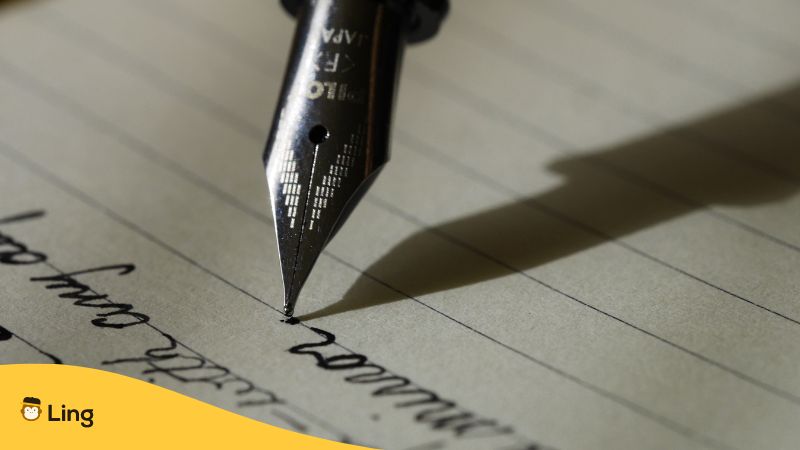
#6 Nevertheless – Nepaisant To
When you want to emphasize a contrast despite the previous point, “Nepaisant to” comes to the rescue.
- Example: Nors lauke buvo šaltas vėjas, nepaisant to, pasivaikščiojome po miestą.
Translation: Although there was a cold wind outside present time, nevertheless, we took a walk around the city.
#7 Meanwhile – Tuo Tarpu
“Tuo tarpu” is used to introduce a contrasting idea while focusing on the same reason in a different timeframe.
- Example: Aš dirbau, tuo tarpu mano draugas mokėsi.
Translation: I was working; meanwhile, my friend was studying.
#8 Finally – Galiausiai
This phrase marks the end of a series of points or arguments, introducing the ultimate idea and the same token.
- Example: Praeitą savaitę turėjome daug užsiėmimų – pirmadienį sportas, antradienį mokslai, o galiausiai, šeštadienį, šventėme gimtadienį.
Translation: Last week we had a lot of activities – sports on Monday, studies on Tuesday, and finally, we celebrated a birthday on Saturday.
Check out Lithuanian festivals & traditions to check out cool Lithuanian culture facts!

#9 Otherwise – Kitu Atveju
“Kitu atveju” is used to present an alternative outcome or a different scenario.
- Lithuanian: Turėkite su savimi skėtį – kitu atveju gali pasireikšti bado jausmas.
English: Bring a snack with you – otherwise, you might feel hungry.
#10 In Summary – Apibendrinant
When you want to summarize the main points of your discussion, “Apibendrinant” is your go-to transition phrase.
- Lithuanian: Apibendrinant, ši knyga yra įdomus pasakojimas apie nuotykius lauke.
English: In summary, this book is an intriguing tale of outdoor adventures.
#11 For Example – Pavyzdžiui
“Pavyzdžiui” introduces an example Lithuanian word to support or illustrate the previous statement.
- Lithuanian: Mėgstame gaminti įvairius patiekalus, pavyzdžiui, picas ir sriubas.
English: We enjoy cooking various dishes, for example, pizzas and soups.

#12 In Fact – Iš Tikrųjų
“Iš tikrųjų” is used to emphasize the truth or reality of the following statement.
- Lithuanian: Jis pasirodė iš tikrųjų gerai pažįstamas mokytojui.
English: He turned out to be in fact well-known to the teacher.
#13 In Conclusion – Baigiant
A transition word similar to “Apibendrinant,” “Baigiant” signals the end of a discussion or argument.
- Lithuanian: Baigiant, noriu pasakyti, kad šis projektas buvo didelis iššūkis, bet ir puikus mokymasis.
English: In conclusion, I want to say that this project was a big challenge but also a great learning experience.
What Else Did You Learn In These Lithuanian Transition Words?
As you continue your journey through the world of Lithuanian grammar, the final analysis of these transition words will serve as invaluable guides, helping you navigate the intricacies of expression.
By mastering the art of using transition words, you’ll not only communicate more effectively but also gain a deeper appreciation for the nuances that make the Lithuanian language unique. So, take these words, practice them in context, and watch your language skills flourish!
Learn Lithuanian With Ling
The Ling app is a highly researched app meant for a fun and personalized language-learning experience. Aside from Lithuanian, there are over 60+ foreign languages to learn on Ling. Download it today to understand Lithuanian!
